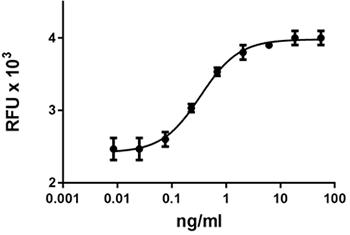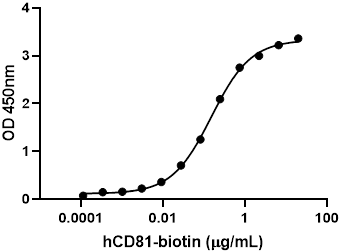- Regulatory Status
- RUO
- Other Names
- Tumor necrosis factor receptor superfamily member 10B (TNFRSF10B), TNF-related apoptosis-inducing ligand receptor 2 (TRAIL R2), TRAIL receptor 2, Death receptor 5 (DR5), CD262, KILLER, TRICK2
- Ave. Rating
- Submit a Review
- Product Citations
- publications

-

Human TNFRSF10B inhibits the cytotoxic effect of recombinant human TRAIL/TNFSF10 in mouse L929 cells. -

Stability testing for human TNFRSF10B. Human TNFRSF10B was aliquoted in PBS at 0.2 mg/ml and one aliquot was kept at 4°C (control) and another was freeze-thawed four times (4 x freeze-thaws). After this procedure, the samples were tested for their ability to inhibit the cytotoxic effect of recombinant human TRAIL/TNFSF10 (12 ng/ml, Cat. No. 752902) in mouse L929 cells.
TNFRSF10B, also called TRAIL R2 and DR5, is a member of the TNF receptor superfamily. It contains a cysteine-rich extracellular domain, a transmembrane domain and an intracellular death domain, which mediates interactions between death receptor and death domain-containing adaptor proteins. When the trimeric ligand TRAIL (TNFSF10) is bound, homotrimer TNFRSF10B interacts with the adaptor protein Fas-associated death domain (FADD), in turn recruits caspase-8 and assembles a death-inducing signaling complex (DISC) that initiates apoptosis. There are decoy receptors, TRAIL R3 (DcR1), TRAIL R4 (DcR2), and OPG, which antagonize the apoptotic effect via competitive ligand binding. Several evidences indicated that TNFRSF10B play roles in tumorigenesis, immune response, and DNA damage response. Some studies have suggested that TNFRSF10B contributes more than TNFRSF10A (TRAIL R1) to TRAIL-induced apoptosis in cancer cells that express both receptors. In addition, agonistic monoclonal antibodies against TNFRSF10B, which can induce apoptosis in the absence of TRAIL, are used for cancer therapies. Loss of TNFRSF10B promotes lymphomagenesis and metastasis. Squamous cell carcinoma of the head and the neck may be caused by the mutation of TNFRSF10B. Recent study demonstrated that TNFRSF10B associates with CD40 and negatively regulates CD40L-induced NF-κB activation and proliferation in primary human B cells. The expression of TNFRSF10B is inducible and up-regulated by DNA damage in p53-dependent manner. The TNFRSF10B deficiency mice showed decreased survival after exposure to ionizing radiation. In human, there are three isoforms produced by alternative splicing.
Product DetailsProduct Details
- Source
- Human TNFRSF10B, amino acid (Ala54-Glu182) (Accession #Q6FH58), with a linker and C-terminus Fc and His tag, was expressed in 293E cells.
- Molecular Mass
- The 370 amino acid recombinant protein has a predicted molecular mass of approximately 41.63 kD. The DTT-reduced and non-reduced protein migrates at approximately 45 and 90 kD respectively by SDS-PAGE. The predicted N-terminal amino acid is Ala.
- Purity
- > 95%, as determined by Coomassie stained SDS-PAGE.
- Formulation
- 0.22 µm filtered protein solution is in 1x PBS.
- Endotoxin Level
- Less than 0.1 EU/µg cytokine as determined by the LAL method.
- Concentration
- 10 and 25 µg sizes are bottled at 200 µg/mL. 100 µg size and larger sizes are lot-specific and bottled at the concentration indicated on the vial. To obtain lot-specific concentration and expiration, please enter the lot number in our Certificate of Analysis online tool.
- Storage & Handling
- Unopened vial can be stored between 2°C and 8°C for up to 2 weeks, at -20°C for up to six months, or at -70°C or colder until the expiration date. For maximum results, quick spin vial prior to opening. The protein can be aliquoted and stored at -20°C or colder. Stock solutions can also be prepared at 50 - 100 µg/mL in appropriate sterile buffer, carrier protein such as 0.2 - 1% BSA or HSA can be added when preparing the stock solution. Aliquots can be stored between 2°C and 8°C for up to one week and stored at -20°C or colder for up to 3 months. Avoid repeated freeze/thaw cycles.
- Activity
- The ED50 is 0.3-1.5 ng/mL, as determined by inhibition of human TRAIL-mediated cytotoxicity (measured by Deep Blue Cell Viability™ Kit, Cat. No. 424701) on L929 cells in the presence of 12 ng/mL cross-linked human TRAIL (Cat. No. 752902) and 1 µg/ml Actinomycin D.
- Application
-
Bioassay
- Application Notes
-
BioLegend carrier-free recombinant proteins provided in liquid format are shipped on blue-ice. Our comparison testing data indicates that when handled and stored as recommended, the liquid format has equal or better stability and shelf-life compared to commercially available lyophilized proteins after reconstitution. Our liquid proteins are verified in-house to maintain activity after shipping on blue ice and are backed by our 100% satisfaction guarantee. If you have any concerns, contact us at tech@biolegend.com.
Antigen Details
- Structure
- Homodimer, disulfide bond-linked
- Distribution
-
Membrane; heart, lung, kidney, intestine, bladder, mammary gland, ovary, placenta.
- Function
- TNFRSF10B play roles in tumorigenesis, immune response, and DNA damage response. TNFRSF10B induces apoptosis upon the binding of the ligand TNFSF10.
- Interaction
- TRADD
- Ligand/Receptor
- TRAIL (TNFSF10)
- Biology Area
- Apoptosis/Tumor Suppressors/Cell Death
- Molecular Family
- Soluble Receptors, Cytokine/Chemokine Receptors
- Antigen References
-
- Walczak H et al. 1997. EMBO J. 16: 5386.
- Ashkenazi A. 2002. Nat. Rev. Cancer. 2: 420.
- LeBlanc HN & Ashkenazi A. 2003. Cell Death Differ. 10: 66.
- Kelley RF et al. 2005. J. Biol. Chem. 280: 2205.
- Johnstone RW et al. 2008. Nat. Rev. Cancer. 8: 782.
- Wu GS et al. 1997. Nat. Genet. 17: 141.
- Wu GS et al. 1999. Cancer Res. 59: 2770.
- Pai SI et al. 1998. Cancer Res. 58: 3513.
- Finnberg N et al. 2008. J. Clin. Invest. 118: 111.
- Grosse-Wilde A et al. 2008. J. Clin. Invest. 118: 100.
- Finnberg N et al. 2005. Mol. Cell Biol. 25: 2000.
- Smulski CR et al. 2017. Cell Death Dis. 8: e2601.
- Gene ID
- 8795 View all products for this Gene ID
- UniProt
- View information about TNFRSF10B on UniProt.org
Related FAQs
- Why choose BioLegend recombinant proteins?
-
• Each lot of product is quality-tested for bioactivity as indicated on the data sheet.
• Greater than 95% Purity or higher, tested on every lot of product.
• 100% Satisfaction Guarantee for quality performance, stability, and consistency.
• Ready-to-use liquid format saves time and reduces challenges associated with reconstitution.
• Bulk and customization available. Contact us.
• Learn more about our Recombinant Proteins. - How does the activity of your recombinant proteins compare to competitors?
-
We quality control each and every lot of recombinant protein. Not only do we check its bioactivity, but we also compare it against other commercially available recombinant proteins. We make sure each recombinant protein’s activity is at least as good as or better than the competition’s. In order to provide you with the best possible product, we ensure that our testing process is rigorous and thorough. If you’re curious and eager to make the switch to BioLegend recombinants, contact your sales representative today!
- What is the specific activity or ED50 of my recombinant protein?
-
The specific activity range of the protein is indicated on the product datasheets. Because the exact activity values on a per unit basis can largely fluctuate depending on a number of factors, including the nature of the assay, cell density, age of cells/passage number, culture media used, and end user technique, the specific activity is best defined as a range and we guarantee the specific activity of all our lots will be within the range indicated on the datasheet. Please note this only applies to recombinants labeled for use in bioassays. ELISA standard recombinant proteins are not recommended for bioassay usage as they are not tested for these applications.
- Have your recombinants been tested for stability?
-
Our testing shows that the recombinant proteins are able to withstand room temperature for a week without losing activity. In addition the recombinant proteins were also found to withstand four cycles of freeze and thaw without losing activity.
- Does specific activity of a recombinant protein vary between lots?
-
Specific activity will vary for each lot and for the type of experiment that is done to validate it, but all passed lots will have activity within the established ED50 range for the product and we guarantee that our products will have lot-to-lot consistency. Please conduct an experiment-specific validation to find the optimal ED50 for your system.
- How do you convert activity as an ED50 in ng/ml to a specific activity in Units/mg?
-
Use formula Specific activity (Units/mg) = 10^6/ ED50 (ng/mL)

 Login/Register
Login/Register 








_Fc_Human_RECOM_BA_081914.jpg)



Follow Us